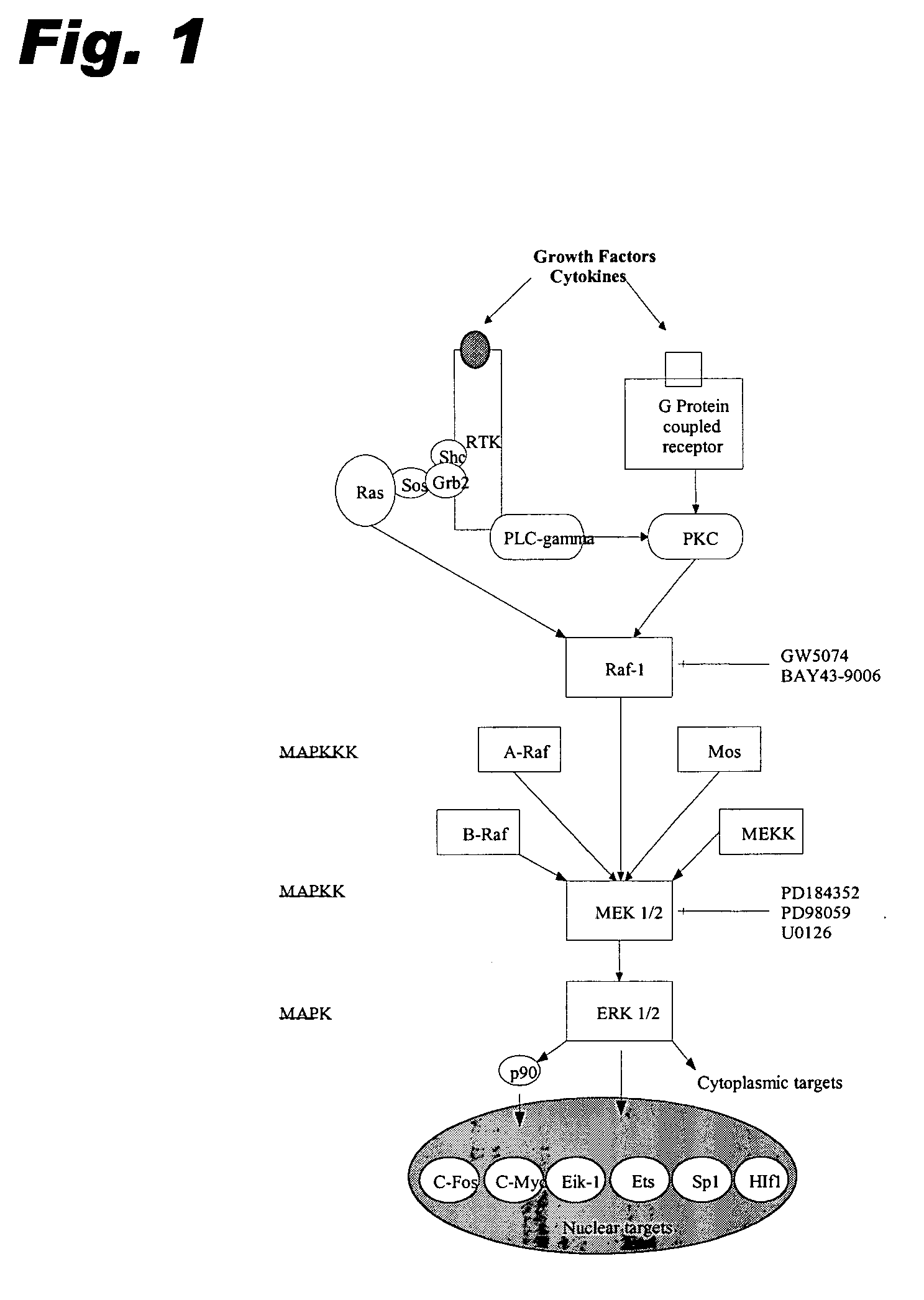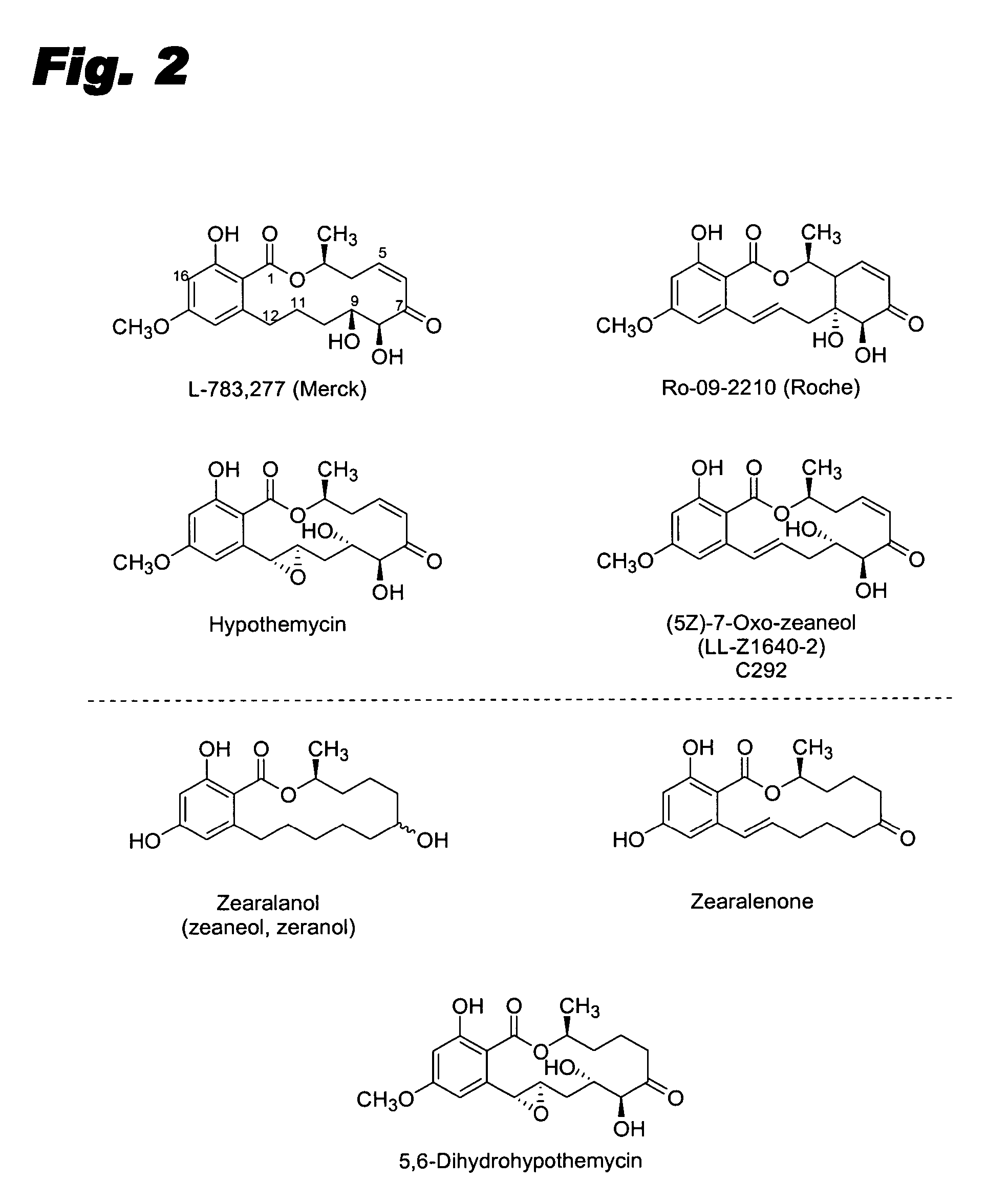Specific kinase inhibitors
a specific kinase and inhibitor technology, applied in the field of compound drugs, can solve the problems of insufficient specific inhibition of a particular signaling pathway protein to obtain a desired therapeutic effect, detrimental to normal cells, and defeating the purpose of targeting the signaling pathway protein in the first instan
- Summary
- Abstract
- Description
- Claims
- Application Information
AI Technical Summary
Benefits of technology
Problems solved by technology
Method used
Image
Examples
example 1
Production of Resorcylic Acid Lactones
[0226] Hypothemycin or (5Z)-7-oxozeaneol can be purified from the fermentation of Hypomyces subiculosus ATCC 44392 following literature procedures. An alternative source of these and closely related resorcylic acid lactones, known as the aigialomycins, is the fermentation of the Agialus parvus strain. Other resorcylic acid lactone compounds of the invention can be synthesized in accordance with this disclosure and methodology described in the literature. The structures of isolated compounds can be confirmed by NMR and MS analysis of the purified material. The 3H or 14C form of one of the lactones or analogs thereof can be prepared commercially (e.g. Moravek Biochemicals; Brea, Calif.) by a chemical or enzymatic semi-synthesis method and its structure verified by chromatographic and spectroscopic analysis. The present invention also provides a method for obtaining a mutant strain that produces (5Z)-7-oxozeaneol or 15-desmethyl hypothemycin inste...
example 2
Kinetic Analysis of Target Cys Kinase Inhibition by the Lactone
[0227] This example illustrates one method for demonstrating that a compound can form a Michael adduct with a target protein kinase, using MEK1, ERK2 and several mitogen receptor kinases as illustrative protein kinases. A hallmark of covalent adduct formation between an inhibitor and enzyme is “time-dependent inhibition” of enzyme activity.
[0228] Typically, one measures the increase in inhibition of protein kinase activity in the presence of inhibitor over time. In one method, aliquots of a “pre-incubation” reaction mixture containing enzyme and inhibitor are assayed for activity (initial velocities) over time; increased inhibition or decreased initial velocities will be observed over time as the Michael adduct forms (Walsh, C., Enzyme Reaction Mechanisms, W.H. Freeman & Co., 1979, pp 86-94). In a second method, the time dependent loss of activity is measured as “progress curves” that measure and analyze product formed...
example 3
Determination of Covalent Bond Formation
[0238] In a Michael reaction, which is in principle a reversible reaction, the apparent affinity between free and covalently-bound ligand is the product of the two dissociation constants (Kreversible×Kcovalent) involved in the reaction, and formation / disruption of the complex is in theory reversible because the protein catalyzes reactions in both directions. Denaturation of the protein obliterates catalysis in both directions, and denatured Michael adducts are usually sufficiently stable that they can be physically isolated and quantitated. For example, although native FdUMP-thymidylate synthase Michael adducts are slowly but completely reversible, SDS denaturation provides stable, isolable complexes (D. V. Santi et al., Biochemistry, 1974, 13, 471; Methods in Enzymol. 1977, 46, 307-312.
[0239] Of course, if the complex does not involve a covalent adduct, denaturation of the protein results in immediate dissociation of the inhibitor. Thus, a ...
PUM
 Login to View More
Login to View More Abstract
Description
Claims
Application Information
 Login to View More
Login to View More - R&D
- Intellectual Property
- Life Sciences
- Materials
- Tech Scout
- Unparalleled Data Quality
- Higher Quality Content
- 60% Fewer Hallucinations
Browse by: Latest US Patents, China's latest patents, Technical Efficacy Thesaurus, Application Domain, Technology Topic, Popular Technical Reports.
© 2025 PatSnap. All rights reserved.Legal|Privacy policy|Modern Slavery Act Transparency Statement|Sitemap|About US| Contact US: help@patsnap.com



